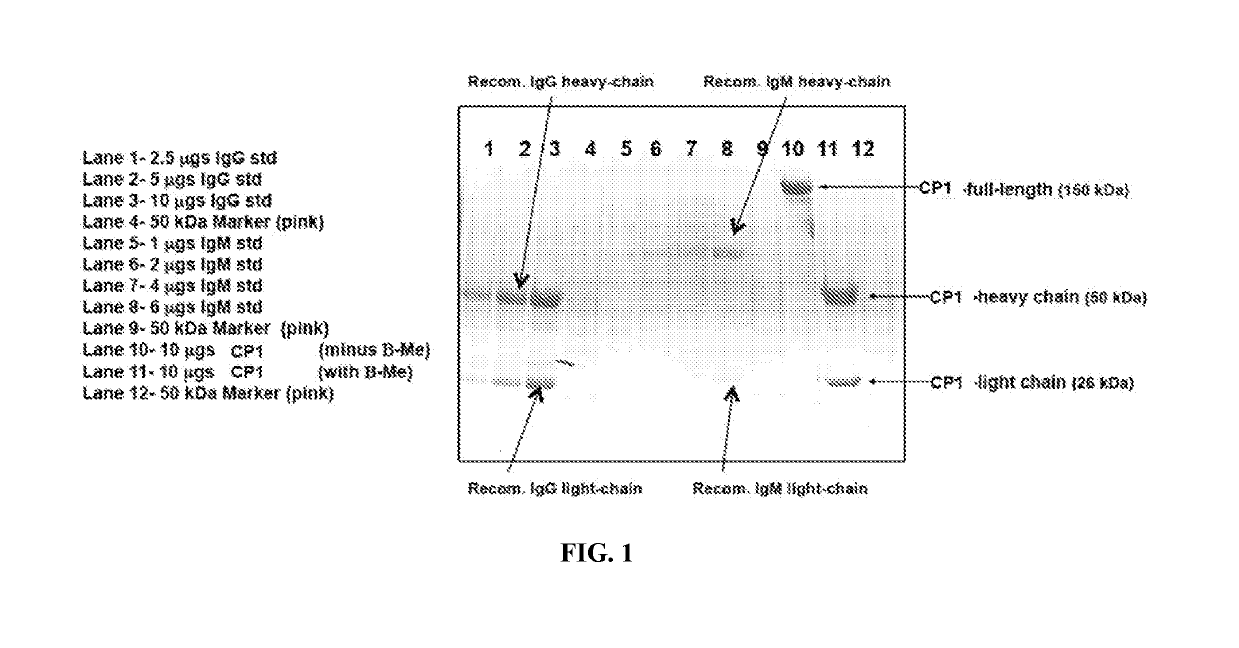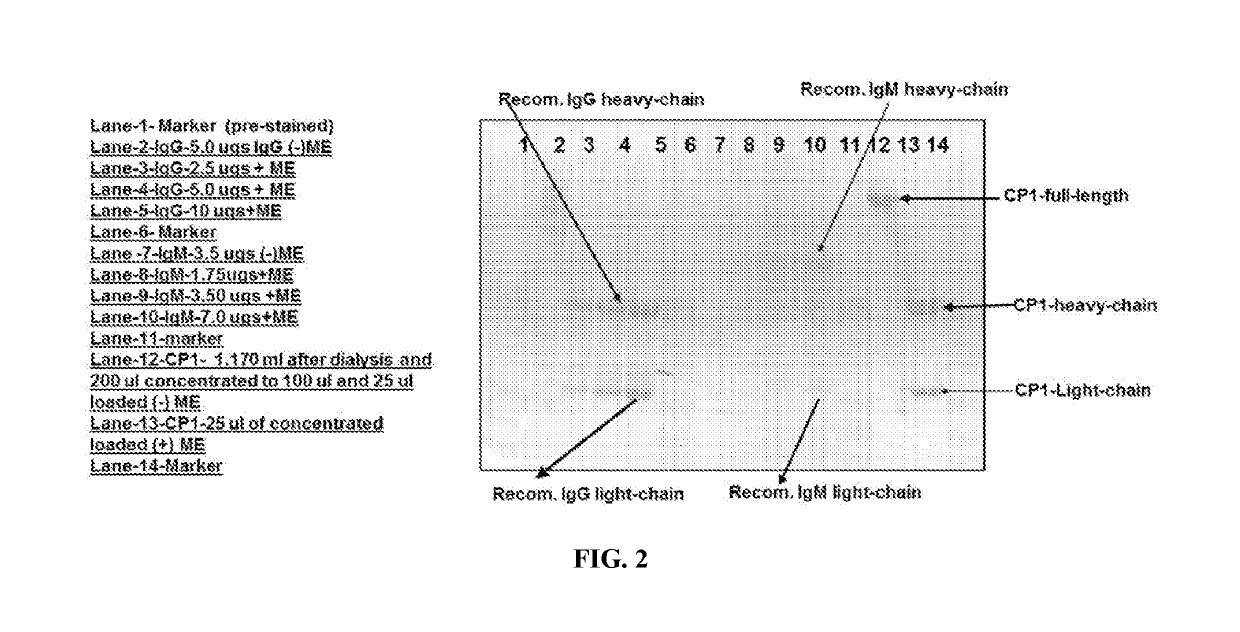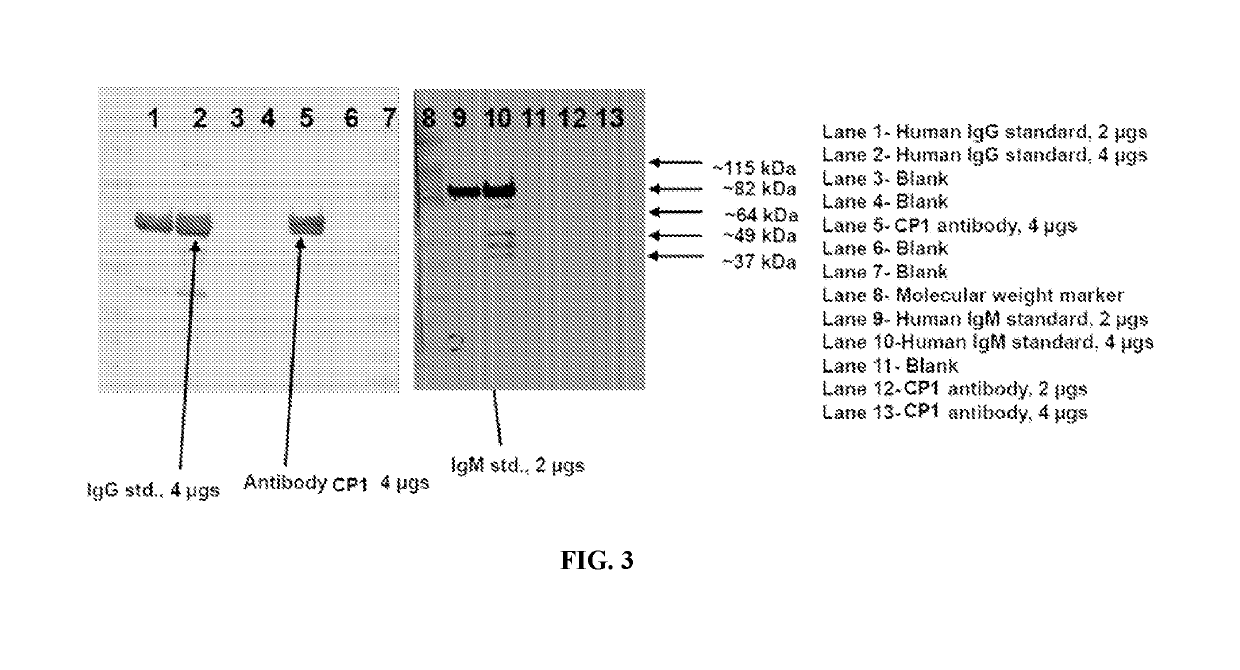Anti-nucleolin antibodies
a technology of anti-nucleotide antibodies and anti-nucleotide, which is applied in the field of anti-nucleotide antibodies, can solve the problems of limited success, untapped potential for therapeutic agents, and “serum sickness" and achieve the effect of reducing the size of tumors
- Summary
- Abstract
- Description
- Claims
- Application Information
AI Technical Summary
Benefits of technology
Problems solved by technology
Method used
Image
Examples
example 1
g and Purification of Antibody CP1 from Human B Cells (CP1)
[0237]Cells from each parental B-cell lines were thawed and expanded. The cells were cultured in regular growth media (RPMI) supplemented with 10% FBS. The culture was subcloned by seeding 96-well plates at three different densities (2 cells, 1 cell, and 0.5 cells / well). The clonal outgrowth was monitored over at least a 2 week timeframe. An antigen-specific ELISA (“nucleolin ELISA”) was used to detect anti-nucleolin antibodies and screen single-cell clones. Positive wells were counter-screened using an anti-human IgG ELISA to estimate the antibody titers in the positive wells. Up to ten positive subclones per parental B cell line were expanded and cryopreserved in banks of at least twenty vials each. Cells were frozen in RPMI containing 5% DMSO. A TRIZOL extract was prepared from 1×107 cells from each subclone frozen above at the time of banking. RNA and oligo-dT primed cDNA were prepared from each sample. The cDNA from eac...
example 2
n of Antibody CP1 from Recombinant Cells (CP1(RC))
[0239]CHO3E7 (Chinese hamster ovary) cells with an initial density of 2.1×106 cells / mL, in a culture medium of F17 supplemented with 0.1% Pluronic F-68, 4 mM GlutaMAX, was transfected with either CP1 gamma heavy chain / kappa light chain or CP1 gamma heavy chain / lambda light chain. cDNA encoding was synthetically produced with codon optimization for mammalian cell expression and cloned into expression vector pTT5 at the indicated restriction sites by standard methods. Two, 30 mL cultures of CHO3E7 cells in 125 mL shake flasks were transfected with 1 mg of plasmid DNA / L culture using PolyPlus linear Q-PEI at a 1:4 (w / v) DNA:PEI ratio. Cultures were supplemented with 4.5 mL CD Efficient Feed B (Life Technologies) 24 hours post transfection. Culture parameters were monitored using a ViCell XR for density and viability.
[0240]Culture supernatants were harvested 10 days post transfection (6 days for the second transfection) via centrifugatio...
example 3
o Recombinant Nucleolin by ELISA Assay
[0244]Reagents: Goat anti-human IgG Ab-HRP Antibody produced by Santa Cruz as nonspecific IgG Control, recombinant nucleolin quantitation by nanodrop (Yoko Otake), and femto-ELISA-HRP kit.
[0245]Preparation: 100 μl binding buffer (control) or recombinant nucleolin (containing 200, 400 or 800 ng) was added to designated wells in an Immuno 96 well plate. The plate was incubated for 1 h on orbital shaker @ 100 rpm at room temp. After 1 h incubation, the plate was carefully inverted to empty and gently tap out residual liquid. 200 μl diluted 1×NAP-blocker was added to each well and incubate the plate for 15 min on orbital shaker @ 100 rpm. After incubation, carefully invert the plate to empty and gently tap out residual liquid.
[0246]Primary Antibody incubation: 100 μl of serial diluted supernatant solution in blocking buffer was incubated for 1 h at room temp on an orbital shaker @ 100 rpm. After incubation, the plate was carefully inverted to empty ...
PUM
 Login to View More
Login to View More Abstract
Description
Claims
Application Information
 Login to View More
Login to View More - R&D
- Intellectual Property
- Life Sciences
- Materials
- Tech Scout
- Unparalleled Data Quality
- Higher Quality Content
- 60% Fewer Hallucinations
Browse by: Latest US Patents, China's latest patents, Technical Efficacy Thesaurus, Application Domain, Technology Topic, Popular Technical Reports.
© 2025 PatSnap. All rights reserved.Legal|Privacy policy|Modern Slavery Act Transparency Statement|Sitemap|About US| Contact US: help@patsnap.com



